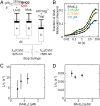UvrD helicase activation by MutL involves rotation of its 2B subdomain
- PMID: 31363055
- PMCID: PMC6697780
- DOI: 10.1073/pnas.1905513116
UvrD helicase activation by MutL involves rotation of its 2B subdomain
Abstract
Escherichia coli UvrD is a superfamily 1 helicase/translocase that functions in DNA repair, replication, and recombination. Although a UvrD monomer can translocate along single-stranded DNA, self-assembly or interaction with an accessory protein is needed to activate its helicase activity in vitro. Our previous studies have shown that an Escherichia coli MutL dimer can activate the UvrD monomer helicase in vitro, but the mechanism is not known. The UvrD 2B subdomain is regulatory and can exist in extreme rotational conformational states. By using single-molecule FRET approaches, we show that the 2B subdomain of a UvrD monomer bound to DNA exists in equilibrium between open and closed states, but predominantly in an open conformation. However, upon MutL binding to a UvrD monomer-DNA complex, a rotational conformational state is favored that is intermediate between the open and closed states. Parallel kinetic studies of MutL activation of the UvrD helicase and of MutL-dependent changes in the UvrD 2B subdomain show that the transition from an open to an intermediate 2B subdomain state is on the pathway to helicase activation. We further show that MutL is unable to activate the helicase activity of a chimeric UvrD containing the 2B subdomain of the structurally similar Rep helicase. Hence, MutL activation of the monomeric UvrD helicase is regulated specifically by its 2B subdomain.
Keywords: activation; conformational selection; helicase; mismatch repair; single molecule fluorescence.
Conflict of interest statement
The authors declare no conflict of interest.
Figures





Similar articles
-
Large domain movements upon UvrD dimerization and helicase activation.Proc Natl Acad Sci U S A. 2017 Nov 14;114(46):12178-12183. doi: 10.1073/pnas.1712882114. Epub 2017 Oct 30. Proc Natl Acad Sci U S A. 2017. PMID: 29087333 Free PMC article.
-
Rotations of the 2B sub-domain of E. coli UvrD helicase/translocase coupled to nucleotide and DNA binding.J Mol Biol. 2011 Aug 19;411(3):633-48. doi: 10.1016/j.jmb.2011.06.019. Epub 2011 Jun 17. J Mol Biol. 2011. PMID: 21704638 Free PMC article.
-
Regulation of UvrD Helicase Activity by MutL.J Mol Biol. 2018 Oct 19;430(21):4260-4274. doi: 10.1016/j.jmb.2018.08.022. Epub 2018 Aug 30. J Mol Biol. 2018. PMID: 30171840 Free PMC article.
-
Roles of the C-Terminal Amino Acids of Non-Hexameric Helicases: Insights from Escherichia coli UvrD.Int J Mol Sci. 2021 Jan 20;22(3):1018. doi: 10.3390/ijms22031018. Int J Mol Sci. 2021. PMID: 33498436 Free PMC article. Review.
-
Lessons learned from UvrD helicase: mechanism for directional movement.Annu Rev Biophys. 2010;39:367-85. doi: 10.1146/annurev.biophys.093008.131415. Annu Rev Biophys. 2010. PMID: 20192763 Free PMC article. Review.
Cited by
-
Structural basis of Gabija anti-phage defence and viral immune evasion.Nature. 2024 Jan;625(7994):360-365. doi: 10.1038/s41586-023-06855-2. Epub 2023 Nov 22. Nature. 2024. PMID: 37992757 Free PMC article.
-
Structural Basis for Dimerization and Activation of UvrD-family Helicases.bioRxiv [Preprint]. 2024 Sep 6:2024.09.05.611425. doi: 10.1101/2024.09.05.611425. bioRxiv. 2024. Update in: Proc Natl Acad Sci U S A. 2025 Mar 11;122(10):e2422330122. doi: 10.1073/pnas.2422330122. PMID: 39282289 Free PMC article. Updated. Preprint.
-
Structural and functional studies of SF1B Pif1 from Thermus oshimai reveal dimerization-induced helicase inhibition.Nucleic Acids Res. 2021 Apr 19;49(7):4129-4143. doi: 10.1093/nar/gkab188. Nucleic Acids Res. 2021. PMID: 33784404 Free PMC article.
-
Engineered helicase replaces thermocycler in DNA amplification while retaining desired PCR characteristics.Nat Commun. 2022 Oct 23;13(1):6312. doi: 10.1038/s41467-022-34076-0. Nat Commun. 2022. PMID: 36274095 Free PMC article.
-
Mycobacterium tuberculosis DNA repair helicase UvrD1 is activated by redox-dependent dimerization via a 2B domain cysteine.Proc Natl Acad Sci U S A. 2022 Feb 22;119(8):e2114501119. doi: 10.1073/pnas.2114501119. Proc Natl Acad Sci U S A. 2022. PMID: 35173050 Free PMC article.
References
-
- Iyer R. R., Pluciennik A., Burdett V., Modrich P. L., DNA mismatch repair: Functions and mechanisms. Chem. Rev. 106, 302–323 (2006). - PubMed
-
- Sancar A., DNA excision repair. Annu. Rev. Biochem. 65, 43–81 (1996). - PubMed
-
- Heller R. C., Marians K. J., Non-replicative helicases at the replication fork. DNA Repair (Amst.) 6, 945–952 (2007). - PubMed
Publication types
MeSH terms
Substances
Grants and funding
LinkOut - more resources
Full Text Sources

